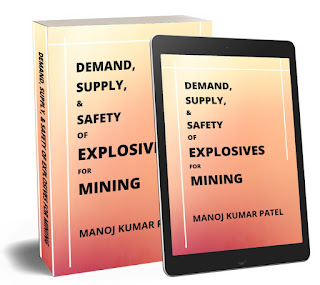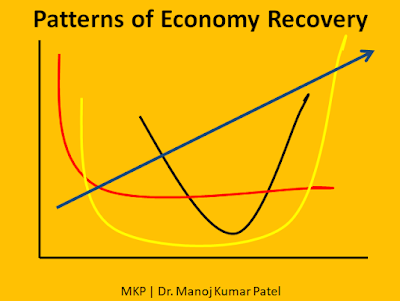Business, supply, demand and safety (BSDS) in explosives for mining
This article is an abstract of the original book titled' "Demand, supply, & safety of explosives for mining".
This book is on multi aspects of chemical fertilizers, ammonium nitrate, mining, and commercial explosives. This book is written by working out data on these hazardous materials so that readers and policymakers get a ready reference to these materials. The author has considered all the four sides that can affect India with respect to economical growth in the safest manner. DSBS is an acronym for the four words – Demand, Supply, Business, and Safety. The book is full of data.
India
produces about 1200 million tonnes of fuels, metallic minerals, and
non-metallic minerals, 8086 thousand tonnes of lead, manganese, zinc, gypsum,
and Phosphorite, 1600 kilogram of gold, and 31836091 carats of diamond every
year. The common methods of excavation of these materials from the mines are
carried out by the use of explosives.
About 1.4 million tonnes of explosives
having about 830 brand names are used by the mines in India. About 50 numbers
of explosives manufacturing companies produce all these.
India uses about 55 million tonnes of
chemical fertilizers. About 15 different types of chemical fertilizers are
manufactured by 10 large scale plants and 72 small scale plants.
Explosives are necessary for
infrastructural developments, and chemical fertilizers are necessary for the production of food grains and other Agri products.
Ammonium
nitrate is one of the preferred materials in the manufacture of fertilizers,
and explosives.
India produces about 11,00,000 tonnes
of ammonium nitrate.
Huge
quantities of explosives, chemical fertilizers, and ammonium nitrate pose
hazards of different types during their manufacture, storage, transport, and
use. The hazards are related to health, fire, and explosion.
So, we have beautiful roses that need
to be plucked without getting pricked by thorns.
The likes of the Beirut explosion of 4 August 2020 should be the last one in the history of mankind.
This
book is on multi aspects of chemical fertilizers, ammonium nitrate, mining, and
commercial explosives. This book is written by working out data on these
hazardous materials so that readers and policymakers get a ready reference to
these materials. The author has considered all four sides that can affect
India with respect to economic growth in the safest manner. DSBS is an acronym
for the four words – Demand, Supply, Business, and Safety. The book is full of
data.
The best expression for this book is: BUSINESS
AND SAFETY – A TIGHT ROPE WALK.
Resources
are treasured beneath the surface of the earth. Metals, minerals, oils, gases,
diamonds are excavated to provide basic as well as luxurious lifestyles to
humans. Excavation is made possible by the use of explosives, and high energy
materials in combination with ultra mega earthmoving machinery, conveyors, and
vehicles. Explosives and high energy materials are synthesized by the use of
ammonium nitrate as the major ingredient. The percentages of ammonium nitrate
in explosives vary in the range starting from 45% to 95%. Ammonium nitrate, as
a standalone chemical sometimes behaves explosively in certain atmospheric
conditions. Ammonium nitrate is also used as fertilizer to improve the yield of
crops. Its derivatives like calcium ammonium nitrate, diammonium phosphate,
ammonium sulfate, etc are fertilizers. The use of ammonium nitrate is
indispensable, despite the fact that disastrous fire and explosions have taken
place due to ammonium nitrate. The recent explosion in Beirut on 4th
August 2020 is the 31st explosion due to ammonium nitrate during the last
century.
Needs, as well as hazards, are the two
sides of the coins – ammonium nitrate. Its uses are in explosives and as
fertilizers. About 11,00,000 tons of ammonium nitrate are manufactured in
India. The global manufacture of ammonium nitrate is about 22 million tonnes
per year.
India is rich in mineral resources.
It produces about (a) 33327 million tonnes of fuels, metallic minerals, and
non-metallic minerals, (b) 8086 thousand tonnes of lead, manganese, zinc,
gypsum, and Phosphorite, 1600 kilogram of gold, and 31836091 carats of diamond
every year. These are excavated from the mines by the use of explosives.
India, on the other hand, is a major
producer of commercial and mining explosives. There are about 50 odd numbers of
explosive manufacturing industries in India. Cumulatively these industries have
a license to manufacture about 90,00,000 tons of explosives that contain
ammonium nitrate at a 60% level, on average. The installed capacity of Class 2
type (nitrate mixture) explosive manufacture is about 25,00,000 tons per annum.
The Indian mines use about 14,00,000 tons of Class 2 type explosives in
cartridge and bulk form. Thus, on average, 9,00,000 tons of ammonium nitrate is
used every year in India. A good volume of ammonium nitrate is imported into
India through its ports in Vizag, Chennai, and Mumbai. These ports store the
imported quantity of ammonium nitrate for some period of time before these are
dispatched to the explosives manufacturing industries present in different
states of India.
Ammonium nitrate thus is imported, stored,
transported, and used throughout the year pan India. Thus, it is important to
understand the pattern in which ammonium nitrate is used in India.
The author, in this book, has
published results of work carried out with respect to (a) demand, (b) supply,
(c) business (explosive and agriculture), and last but the most important part
namely (d) safety. The book is thus titled – DEMAND, SUPPLY, & SAFETY OF
EXPLOSIVES FOR MINING.
The author has described topics – (i) demand and supply, (ii) atma nirbhar, Bharat
and import, (iii) chemical manufacturing, (iv) TSCA and EU Reach, (v) regulated
chemicals, (vi) overview of chemical regulations in India, (vii) chemical
fertilizers, (viii) MSDS and SDS, (ix) ammonium nitrate as fertilizer, (x)
ammonium nitrate as explosive, (xi) FAQs on ammonium nitrate, (xii) chemistry
of AN, (xiii) demand and supply of AN, (xiv) mining scenario in India, (xv)
safety aspects in AN, and finally (xvi) DSBS in ammonium nitrate is correct or
corrections are needed.
India produces
as many as 95 minerals, which include 4 fuels, 10 metallic, 23 non-metallic, 3
atomic, and 55 minor minerals (including building stones and other materials).
The total value of mineral production (excluding atomic & fuel minerals)
during 2018-19 has been estimated at 1,24,020 crore, which shows an increase of
about 10.11% over that of the previous year
During
2018-19, the estimated value for metallic minerals is 61,009 crore or 49.19% of
the total value and non-metallic minerals including minor minerals are 63,011 crores or 50.81% of the total value.
The number of mines which reported mineral production (excluding atomic, fuel, and minor minerals) in India was 1405 in 2018-19 as against 1430 in the previous year. Out of 1405 reporting mines, most of the mines were reported in Madhya Pradesh followed by Gujarat, Karnataka, Odisha, Andhra Pradesh, Tamil Nadu, Chhattisgarh, Rajasthan, Goa, Maharashtra, and Jharkhand.
|
Number
of Reporting Mines |
|||
|
Sector |
FY 2017 |
FY 2018 |
FY 2019 |
|
All minerals |
1616 |
1430 |
1405 |
|
Metallic minerals |
685 |
638 |
625 |
|
Non-metallic minerals |
931 |
792 |
780 |
The numbers of underground mines in operation mineral-wise (excluding fuel, atomic and minor minerals) are:
|
Number
of Underground Mines |
|||
|
Minerals |
A' |
B' |
Total |
|
Apatite |
- |
1 |
1 |
|
Chromite |
6 |
- |
6 |
|
Copper ore |
5 |
- |
5 |
|
Gold |
4 |
1 |
5 |
|
Lead & Zinc |
8 |
- |
8 |
|
Manganese ore |
9 |
7 |
16 |
|
Rock salt |
- |
1 |
1 |
|
TOTAL |
32 |
10 |
42 |
During 2018-19, Mineral production was reported from 32 States/Union Territories (actual reporting of MCDR from 22 states and estimation of minor minerals for all 32 States/Union Territories) of which the bulk of the value of mineral production (excluding fuel and atomic minerals) of about 90.78% was confined to 10 States. Odisha is in the leading position, in terms of the estimated value of mineral production in the country and had a share of 23.66% in the national output. Next in order was Rajasthan with a share of 17.27% followed by Andhra Pradesh (8.62%), Chhattisgarh (8.49%), Karnataka (8.37%), Telangana (6.73%), and Gujarat (5.20%) in the total value of mineral production. The contribution of States/Regions in the value of mineral production during 2018-19 estimated is pictorially shown below.
The states which have indicated a major increase in the value of mineral
production are Odisha (45.41%), and Jharkhand (21.67%).where as some of the
principal mineral producing states recorded a decrease in the value of mineral
production (excluding fuel & atomic minerals) and those include Goa
(60.90%) and Jammu & Kashmir (2.66%).
The index of the book is as follows:





Comments
Post a Comment